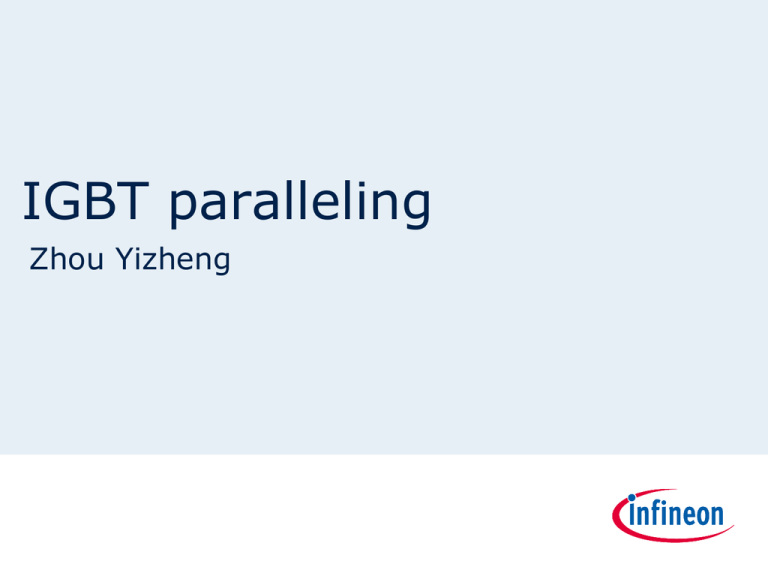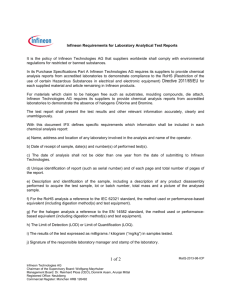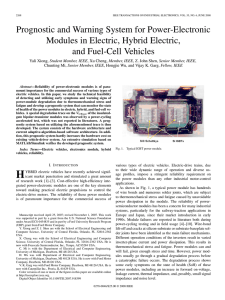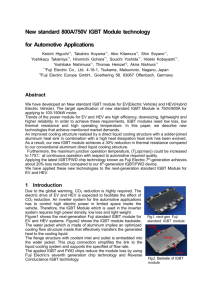
IGBT paralleling
Zhou Yizheng
Current sharing
Current sharing
Static current sharing
¬ Affect conduction losses distribution
Dynamic current sharing
¬ Affect dynamic losses distribution and dynamic stress
Set date
Copyright © Infineon Technologies 2010. All rights reserved.
Page 2
Parameters effecting current balance
Static sharing
X
Commutation loop impedance
AC loop impedance
X
Thermal
X
Set date
X
X
Driver symmetry
Module static parameters
Dynamic sharing
X
Module switching parameters
X
Magnetic field
X
Communicating loop: dynamic & static current sharing
AC loop: Copyright
static©current
sharing
Infineon Technologies 2010. All rights reserved.
Page 3
Test set up
Module: FZ1500R33HE3.
¬ Channel1 IGBT module1 collector current
¬ Channel 2 IGBT module2 collector current
¬ Channel 3 IGBT module1 gate voltage
¬ Channel 4 IGBT module2 gate voltage
Set date
Copyright © Infineon Technologies 2010. All rights reserved.
Page 4
Bus bar symmetry
Symmetrical Busbar
Additional stray
impedance applied
Stray impedance in
the commutation
loop influence both
dynamic current
sharing and static
current sharing. (low
impedance high
current)
Bus bar symmetry
Symmetrical AC path
Unsymmetrical AC path
AC path have no
influence to turn on
dynamic current
sharing, it influence
the static current
sharing, further
influence the turn off
dynamic current
sharing and current
redistribution. (low
impedance high
current)
Bus bar symmetry
20 degree
20 degree
20 degree
20 degree
20 degree
40 degree
20 degree
40 degree
Thermal symmetry
influence static
current sharing
and , but it is not
so strong. (high
temperature low
current). Thermal
symmetry have
almost no influence
to turn on current
sharing, but can
influence turn off
current sharing
Magnetic field
Inductor outside the SB
Inductor Right side in SB
Inductor Left side in SB
Inductor influence for active board
Driver Outside the SB
Driver inside the SB
Driver Outside the SB
Driver inside the SB
Inductor influence to passive board
Magnetic field
For FZ+FZ double pulse test setup:
Cable connection inside bus bar influence both static current
sharing and current redistribution(created magnetic field
influence bus bar impedance), but almost no influence at turn
on.
Magnetic filed of inductor can influence current redistribution
and driver (if the driver is passive adaptor board based)
further influence turn on current sharing and current
redistribution.
If active adaptor board based driver is used, magnetic filed of
inductor have almost no influence on turn on current sharing
Driving conecpt
Isolated
Each IGBT have its own isolated driver core
Active adopt board
One driver core with booster circuit on adaptor board
Passive adopt board(separate Rg)
One driver core with separate gate resistor on
adaptor board
Passive adopt board(merged Rg)
With gate resistor on driver core, just cable to
connect IGBT module gate
Set date
Copyright © Infineon Technologies 2010. All rights reserved.
Page 10
Driving concept
Isolated
Active
Symmetrical bus bar
Merged Rg
Separate Rg
Driving concept
Isolated
Active
Symmetrical bus bar
Merged Rg
Separate Rg
Driving concept
Isolated driver
Unsymmetrical bus bar
Passive separated Rg
Cable length
Merged Rg
20cm / 20 cm
20cm / 100 cm
101cm / 100 cm
20cm / 100 cm
101cm / 100 cm
Separate Rg
20cm / 20 cm
Cable length
Merged Rg
20cm / 20 cm
20cm / 100 cm
101cm / 100 cm
20cm / 100 cm
101cm / 100 cm
Separate Rg
20cm / 20 cm
Ic1 Right IGBT
Ic2 Left IGBT
Vge1 Left IGBT
Vge2 Right IGBT
Driving
Different driver concept shows almost similar turn on/off
performance, at precondition that system is symmetry.
Active board shows a little bit poorer turn on current sharing
performance
Passive board shows high amplitude of current redistribution
and oscillation frequency
In unsymmetrical system, isolated driver shows better turn on
dynamic current sharing and almost similar turn off dynamic
current sharing.
Separate Rg shows better dynamic current sharing than
merged Rg, if gate cable is unsymmetrical.
Module parameters
Vcesat, Vf
Influence static current
sharing
Vth, Vp
Influence dynamic current
sharing
Set date
Copyright © Infineon Technologies 2010. All rights reserved.
Page 17
Module parameters
Same Vcesat class
Set date
Same Vcesat class
Copyright © Infineon Technologies 2010. All rights reserved.
Different Vcesat class
Page 18
Module parameters
Vcesat 3.33
3.31
Vcesat 3.34
3.31
Vcesat 3.31
3.37
Vth
5.90
5.90
Vth
5.86
5.90
Vth
5.90
5.90
Vp
10.33
10.28
Vp
8.93
10.28
Vp
10.33
10.23
Different Vcesat class(+/-1) almost show no influence to static
current sharing. positive temperature coefficient + round
up/down
Different module have quite small influence to module dynamic
current sharing(current redistribution).
Conclusion
Set date
Copyright © Infineon Technologies 2010. All rights reserved.
Page 20
Conclusion
System symmetry is at first priority (including commutation
loop symmetry, AC path symmetry and AC output cable
position).
Based on symmetrical system, either isolated driver or active
adaptor board or passive adaptor board all can get very good
current sharing results.
If cable length for passive adaptor is not same, separated Rg
and emitter Rg is recommended.
Module influence to current sharing is quite small. IGBT Vcesat
class +/-1 is quite Ok for current sharing. It’s better to take
same Vf class module.
System magnetic field effect need to be care about




